Manufacturing Output Falls in September, Aerospace Hit Hard
Industrial production fell 0.3% in September after advancing 0.3% in August. The decline in September was influenced significantly by the strike of Boeing workers and the effects of two hurricanes. Manufacturing output decreased 0.4%, with aerospace and miscellaneous transportation equipment dropping a dramatic 8.3%. At 102.6% of its 2017 average, total industrial production in September was down 0.6% from the same month last year. Capacity utilization edged down to 77.5%, 2.2 percentage points below its long-term average from 1972 to 2023.but was up 1.2% from the same month last year.
In September, major market groups saw mixed results. Among consumer goods, the production of durables decreased 0.7%. On the other hand, the index for nondurables increased 0.5%, helped by a 1.7% rise in energy goods. The business equipment index declined 3.5% in September, weighed down by the sharp 14.2% drop in the production of transit equipment, largely affected by the strike.
Durable goods manufacturing decreased 1.0%. Apart from the dramatic drop in aerospace and miscellaneous transportation equipment, declines occurred in motor vehicles and parts (down 1.5%), furniture and related products (down 1.5%) and electrical equipment, appliances and components (down 1.4%), with slight declines in numerous other durable industry groups. Nondurable goods manufacturing, on the other hand, increased 0.2% in September, with the largest gains in petroleum and coal products (up 1.8%) and printing and support (up 1.0%).
Manufacturing capacity utilization decreased 0.4% to 76.7%, which is 1.6 percentage points below the long-term average.
Full Expensing: Q&A with Sen. James Lankford

The NAM recently talked to Sen. James Lankford (R-OK) to learn what he and his colleagues on the Senate Finance committee are focused on as critical provisions of the Tax Cuts and Jobs Act are set to expire next year. Here’s the full interview:
NAM: Senator Lankford, Congress is facing a “Tax Armageddon” next year, as crucial provisions from 2017’s Tax Cuts and Jobs Act are set to expire. As a member of the Senate Finance committee, what is your focus moving into next year’s debate?
Sen. Lankford: Extending the TCJA is crucial for American families and it creates certainty for businesses, particularly those policies encouraging investment and innovation. Failure to act will result in a tax increase for most American households and 96% of businesses. For greater predictability, Congress should push for as many permanent pro-growth policies as possible. One such policy is the full expensing of new investments, which allows businesses to deduct the cost of machinery and equipment in the year they are purchased. This measure has significantly incentivized capital investment, leading to job creation and economic expansion.
NAM: The 2017 tax reform package implemented full expensing for capital equipment purchases, which manufacturers overwhelmingly utilized in the years following. However, full expensing began to phase out in 2023 and will be completely eliminated from the tax code in 2027. What are you doing to protect this crucial policy?
Sen. Lankford: For the past 20 years, under Republican and Democratic administrations, bonus depreciation has been an essential element of good business tax policy. Bonus depreciation acknowledges that business expenses are not business profits, so they should not be taxed as profits. The 2017 tax bill expanded on that nonpartisan tax policy by allowing businesses to depreciate 100% of their capital and equipment during the purchase year, instead of over years and years of tax returns. That change doesn’t alter how much tax a business can deduct; it simply changes when they can deduct it. With 100% depreciation, a business can deduct its tax in a single year, instead of over several years. That allows a business to invest more capital, hire new employees faster and expand their business. My ALIGN Act will make bonus depreciation a permanent and predictable tax policy for our businesses and manufacturers, and it will encourage economic growth for decades to come.
NAM: As a Senator who was there during the Tax Cuts and Jobs Act, you know how impactful the legislation was for manufacturers to be able to compete on a global level. As we get closer to next year, what are you hearing from stakeholders on the need for pro-growth tax policy so American businesses can engage and grow around the world?
Sen. Lankford: I have connected with Oklahoma businesses—both large and small—to discuss tax policies that affect them and how we can ensure our tax system provides certainty while keeping the U.S. competitive internationally. We must not lose sight of how a competitive tax code drives American investment, which, in turn, strengthens our economic and national security. The TCJA struck a competitive balance with a 21% corporate tax rate and a 20% rate for pass-through businesses.
Some are calling for an increase in the corporate rate to 28%. However, the average corporate tax rate in the EU is 21.3%, with a global average of 23% across 181 jurisdictions. China has a corporate tax rate of 25%, with a reduced 15% rate for new sectors. Moreover, China has significantly expanded its R&D deduction, while the U.S. is shrinking ours. We should reverse the decline of our R&D deduction and permanently encourage businesses of all sizes to remain innovative here in America.
As the Senator from Oklahoma, I’m keenly aware of the connection between a competitive tax code and energy security. As we work to strengthen our national security, now is not the time to target American oil and gas producers. Looking ahead to 2025, I will fight to protect the current treatment of intangible drilling costs (IDCs) in the tax code. IDCs allow oil and natural gas companies to recover these costs more quickly, freeing up funds for reinvestment in development. This not only creates more jobs but also enhances our energy security and keeps energy prices low for American families.
NAM: Thank you, Senator. What else can NAM members do to stay engaged and be a resource for you going into next year?
Sen. Lankford: I encourage everyone to regularly communicate with their congressional delegation about the impacts a lapse in the TCJA would have on their businesses and communities. For example, full expensing drives investments in sectors ranging from rural broadband and agriculture to energy security and manufacturing. These investments directly boost local economic output, create jobs, and enhance the competitiveness of communities in the market. It’s important to share this story as Congress works on a tax bill in 2025.
Rep. Grothman Talks R&D, Taxes at Wisconsin Aluminum Foundry
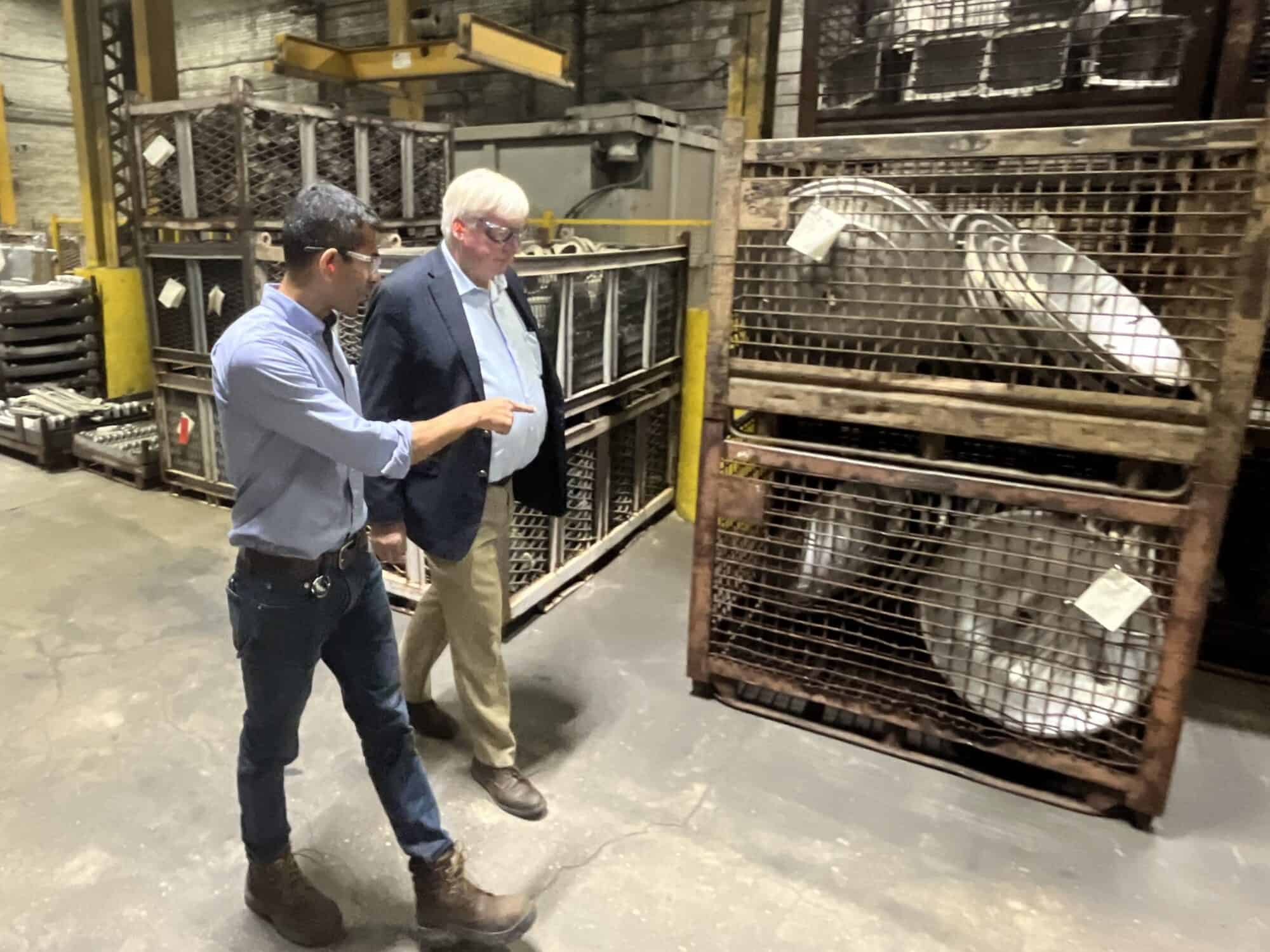
Rep. Glenn Grothman (R-WI) visited Wisconsin Aluminum Foundry in Manitowoc, Wisconsin, as part of a series of facility visits from key members of Congress organized by the NAM. Rep. Grothman, representing a district with one of the largest percentages of its workforce employed in manufacturing, emphasized the importance of key tax policies that keep manufacturers competitive on a global scale.
During the visit, Rep. Grothman toured the facility with Wisconsin Aluminum Foundry CEO Sachin Shivaram and held a roundtable discussion with company and union leadership. Representatives from Wisconsin Manufacturers & Commerce also participated in discussions about the challenges facing manufacturers.
Innovation and R&D: Shivaram showcased the Foundry’s advanced aluminum and bronze casting capabilities during the tour. He also expressed concern about changes in R&D tax treatment, which have increased the cost of innovation.
- “R&D is essential to the future of our business,” said Shivaram, stressing that restoring full R&D expensing is crucial for manufacturers like Wisconsin Aluminum Foundry. With the expiration of first-year R&D expensing in 2022, the burden of financing R&D has become a major obstacle for small and medium-sized manufacturers.
- Rep. Grothman, who strongly supports restoring full R&D expensing, said, “Manufacturers need every incentive to innovate and grow. If we want to maintain our competitive edge, we need to ensure that tax policy encourages, not discourages, investment in R&D.”
Preserving tax reforms: The roundtable addressed the importance of preserving the 2017 Tax Cuts and Jobs Act, which benefited manufacturers by lowering the corporate tax rate and providing a 20% pass-through deduction for small businesses. These provisions are set to expire in 2025, creating uncertainty for manufacturers.
- Rep. Grothman pointed to Wisconsin’s manufacturing and agriculture credit as a model for federal tax policy going forward. The MAC, which substantially reduces state taxes on manufacturing income, has proven effective in supporting Wisconsin’s manufacturers.
- “We should look at expanding these kinds of targeted incentives nationwide,” Rep. Grothman said, noting that a similar approach at the federal level could bolster U.S. manufacturing and global competitiveness.
The local view: WMC President and CEO Kurt Bauer echoed the concerns about the expiration of the 2017 tax reforms.
- “If these tax provisions are allowed to expire, it would put significant strain on Wisconsin’s manufacturers,” Bauer said. “The ability to reinvest in equipment, innovation and workers is crucial for maintaining our global competitiveness, and losing these tax incentives would make that much harder.”
Workforce development: The roundtable also covered workforce development, a critical issue for an industry facing a shortage of skilled workers.
- Shivaram, who chairs the Governor’s Council on Workforce Investment, stressed the importance of expanding access to skills-based education and apprenticeship programs to meet the needs of modern manufacturing. “We need policies that help us train and retain the workforce of the future,” he said.
- Rep. Grothman echoed this sentiment, pledging to support federal workforce development initiatives that prepare workers for careers in advanced manufacturing. “A skilled labor force is the foundation of manufacturing’s future,” he said.
Closing thoughts: “It is critical that tax policy continue to support manufacturers, who are the backbone of our economy,” said Rep. Grothman. “If we allow tax reform to expire, it would result in devastating tax increases—stalling job creation and innovation. It’s on us in Congress to work together to preserve tax reform and encourage investment, protect jobs and keep American manufacturers competitive on the global stage.”
Fighting for a Competitive Future: A Conversation with Sen. James Lankford

As Congress faces the looming expiration of key provisions from the 2017 Tax Cuts and Jobs Act, Sen. James Lankford (R-OK) emphasizes the urgency of extending these policies to safeguard American businesses and families from tax increases.
Ensuring certainty: Sen. Lankford underscored the importance of creating predictability for businesses by making pro-growth policies permanent. “Extending the TCJA is crucial for American families, and it creates certainty for businesses, particularly those policies encouraging investment and innovation,” he told the NAM in a recent conversation. “Failure to act will result in a tax increase for most American households and 96% of businesses. For greater predictability, Congress should push for as many permanent pro-growth policies as possible.”
One policy Sen. Lankford is particularly focused on preserving is full expensing for capital investments, which allows businesses to immediately deduct the cost of machinery and equipment. This measure, he said, has fueled capital investment and accelerated job creation.
Protecting full expensing with the ALIGN Act: Full expensing has been a bipartisan tool in tax policy for two decades, Sen. Lankford points out, highlighting that the TCJA allowed businesses to deduct 100% of capital expenses in the year of purchase. His ALIGN Act aims to make full expensing a permanent fixture in the tax code, fostering long-term economic growth.
- “That change doesn’t alter how much tax a business can deduct; it simply changes when they can deduct it. With 100% depreciation, a business can deduct its tax in a single year, instead of over several years. That allows a business to invest more capital, hire new employees faster and expand their business.”
Global competitiveness and energy security: Drawing from conversations with Oklahoma businesses, Sen. Lankford stressed that keeping the U.S. tax code competitive is critical. While some push for a corporate tax increase, he warned this would undermine America’s global position.
- “The average corporate tax rate in the EU is 21.3%, with a global average of 23% across 181 jurisdictions. China has a corporate tax rate of 25%, with a reduced 15% rate for new sectors. Moreover, China has significantly expanded its R&D deduction, while the U.S. is shrinking ours. We should reverse the decline of our R&D deduction and permanently encourage businesses of all sizes to remain innovative here in America.”
The final word: “I encourage everyone to regularly communicate with their congressional delegation about the impacts a lapse in the TCJA would have on their businesses and communities,” Sen. Lankford said. “It’s important to share this story as Congress works on a tax bill in 2025.”
Read the full interview with Sen. Lankford here.
Solving the Talent Equation at the MI’s Workforce Summit
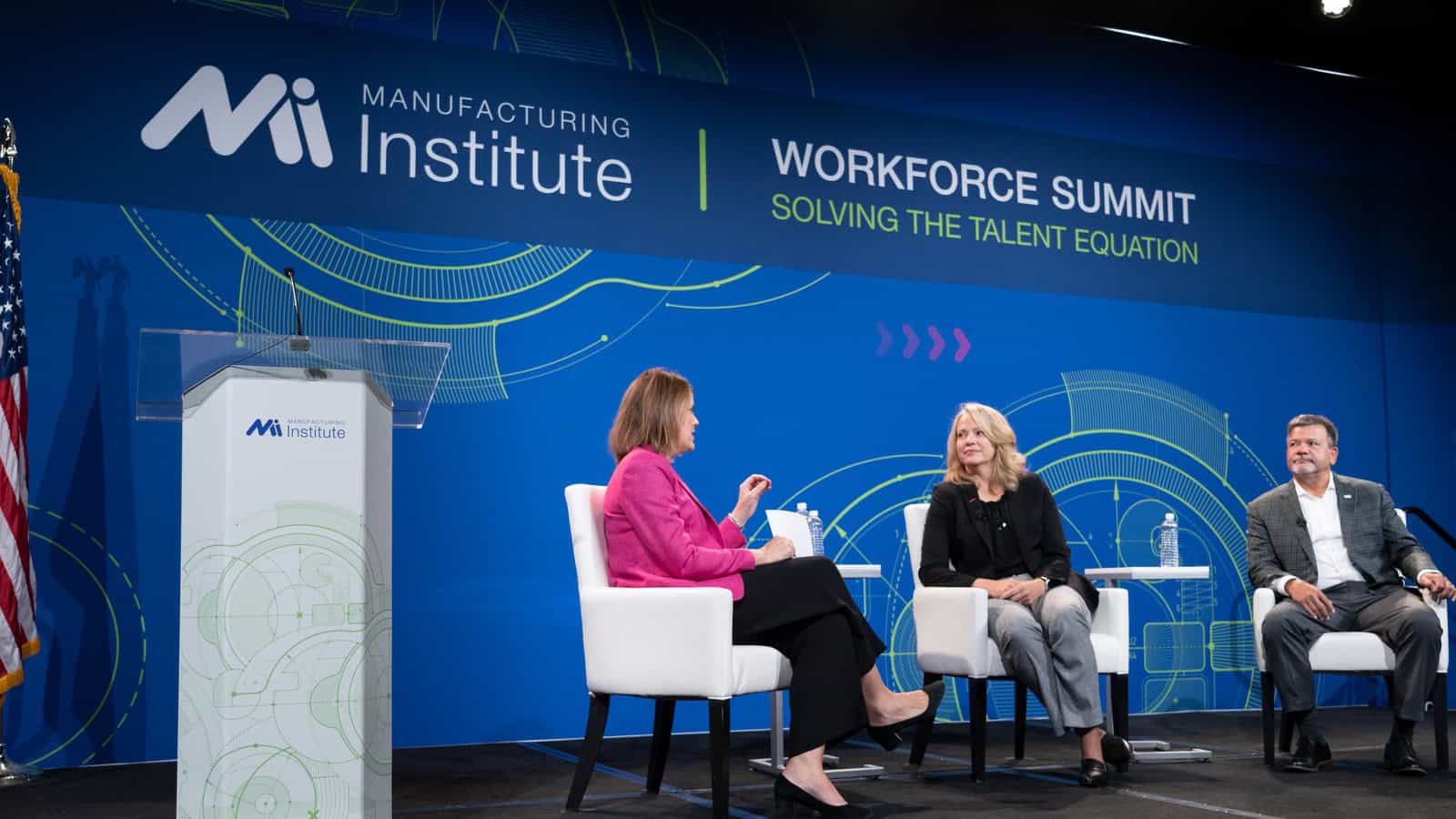
More than 300 leaders and experts gathered in Minneapolis last week to discuss the industry’s talent challenges, from hiring to training and retaining. The Manufacturing Institute’s annual Workforce Summit convened manufacturers, partners from education and training groups, philanthropy leaders and representatives from community-based organizations to share insights and brainstorm solutions.
The backdrop: With more than 500,000 open jobs in the industry, manufacturing leaders are intent on solving the talent equation.
- MI Chief Program Officer Gardner Carrick provided context for attendees. “For the last 7+ years, manufacturers have told the MI that the single biggest challenge they face is finding the right people to employ,” he said. “It is the crisis right in front of us.”
- Carrick urged attendees to “act now, because the system needs help.” However, he also noted that this crisis will take time to fix, saying that manufacturers should “be patient, but be committed.”
Quick insights: The participants brought many new ideas and fresh perspectives to the gathering. Here are some of the highlights:
- Recruitment and hiring: NTT DATA led a session on artificial intelligence technologies that can help with talent attraction, while other sessions focused on changing Americans’ perceptions of the industry and demonstrating that manufacturing is a “cool” field to work in.
- Retention: Mark Rayfield, CEO of Saint-Gobain North America and CertainTeed, highlighted the importance of culture as a retention tool, saying, “Culture is everything. Employees want to work for a place where they are respected.” In a separate session, Jill Wyant, president and CEO of Madison Air, shared why their cultural value of frontline obsession guides how they attract and retain their frontline employees.
- Training: One session focused on training frontline supervisors in methods that boost retention of frontline workers. Other sessions focused on using the FAME USA model (of combined accreditation and training) to cultivate talent for manufacturing facilities.
- Preparing the next generation: Ketchie Inc.’s Andy Silver spoke about the company’s Opportunity Knocks program, an unpaid internship program for high school students that offers real-world learning experience and mentorship. Programs like these can transform young people’s perceptions of the manufacturing industry and set them on rewarding career paths, as Silver noted.
Did you miss it? Don’t worry! There are plenty of ways to get involved in the solutions being driven by the MI, the NAM’s 501(c)3 workforce development and education affiliate.
- Check out the MI’s Solutions Center, a new initiative that will provide manufacturers innovative resources and opportunities to access solutions and best practices on how to tackle the challenges of recruiting, training and retaining talent in today’s competitive landscape. Attendees got a first look, but now we’re sharing it with everyone.
- Get updates directly from the MI on the latest workforce insights and receive information about registering for next year’s Workforce Summit in Charlotte, North Carolina, taking place Oct. 20–22, 2025.
- Want more labor data and insights? Sign up for the MI’s comprehensive Workforce in Focus newsletter to stay up to date on the latest workforce trends.
The last word: “The MI and manufacturers across the country are changing the narrative, raising awareness and finding new ways to get people in the door and retain them,” said MI President and Executive Director Carolyn Lee. “As we face workforce shortages and retention challenges, events like the MI’s Workforce Summit are necessary to help the industry share important insights and ensure the readiness of the future manufacturing workforce.”
Small Manufacturers: Congress Must Restore Full Expensing
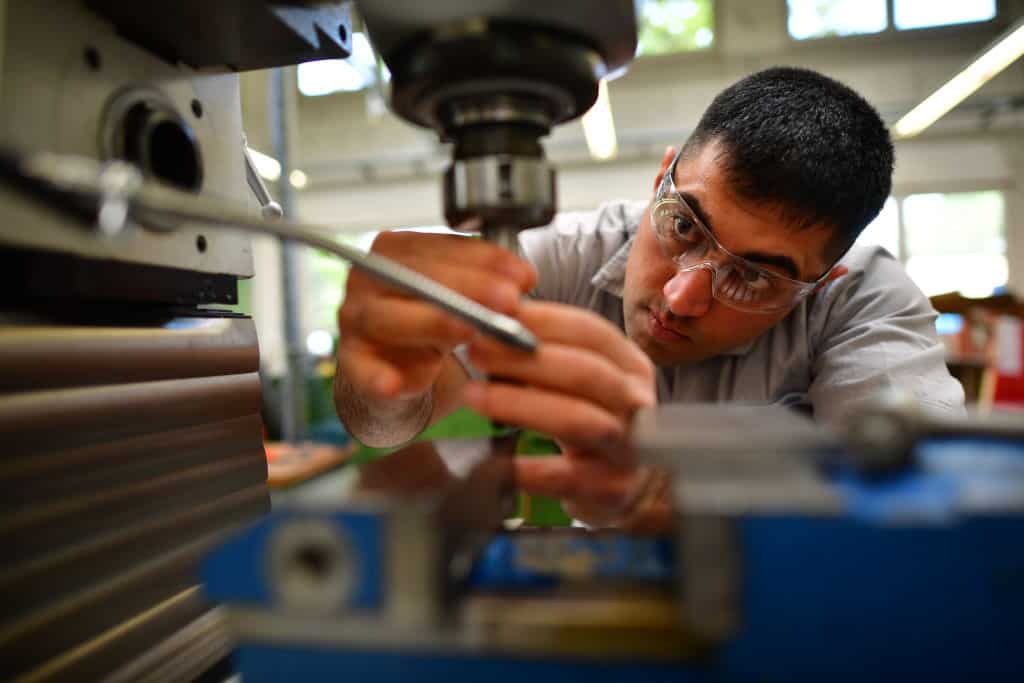
As part of the NAM’s “Manufacturing Wins” tax campaign, small and medium-sized manufacturers are urging Congress to make full expensing of capital equipment purchases permanent, warning that the phaseout of this pro-growth tax provision is harming their ability to invest, grow and compete.
What’s happening: Tax reform allowed manufacturers to immediately expense 100% of the cost of capital equipment purchases. But this provision started to be phased out in 2023, dropping by 20%. It will drop by a further 20% every year until 2027, when it will expire completely.
- Seventy-eight percent of manufacturers said that the expiration of full expensing and other pro-growth tax provisions has decreased their ability to expand U.S. manufacturing activity, according to an NAM Manufacturers’ Outlook Survey from last year.
What’s at stake for manufacturers: Capital-intensive industries like manufacturing are the primary beneficiaries of full expensing.
- Lori Miles-Olund, president of Miles Fiberglass & Composites in Clackamas, Oregon, explained the benefits for her company: “We were able to purchase new equipment that not only made our production more environmentally friendly but also safer and more efficient for employees.”
- Colin Murphy, president and owner of Simmons Knife & Saw in Glendale Heights, Illinois, emphasized how critical full expensing is for global competitiveness: “To remain competitive, we need to continually innovate and consistently invest in new machinery and equipment. But with rising tax bills, it’s becoming harder to do so.”
Delayed investments: Some manufacturers are holding off on equipment purchases due to the uncertain tax landscape.
- “I know exactly where the next capital investment should be installed, but I’ve been delaying this decision,” said Courtney Silver, president and owner of Ketchie in Concord, North Carolina. “[Full expensing] dropped to 60% [in 2024], and the fact that I can’t expense the full value of this investment changes the return on investment calculation.”
- In Hodgkins, Illinois, Pioneer Service recently moved from a 24,000-square-foot building to a 62,000-square-foot building, but it can’t take advantage of all this space without full capital equipment expensing. “We had 13 more machines on order that we’ve put a hold on,” explained CEO and Co-Owner Aneesa Muthana. “Thirteen machines equivalent to about $5 million in capital, and that’s completely on hold until we know what’s going to happen next.”
Calling on Congress: If Congress does not act, accelerated depreciation will be entirely absent from the U.S. tax code for the first time in decades. “This isn’t just about numbers on my financial statements and my tax returns—this is about taking care of people here and in communities across this country working for small manufacturers,” said Silver.
- “Congress must act now to support American manufacturers,” said Murphy. “Our ability to invest in our communities, create jobs and innovate is at risk.”
Rep. Miller-Meeks Calls for PBM Reform at Cemen Tech
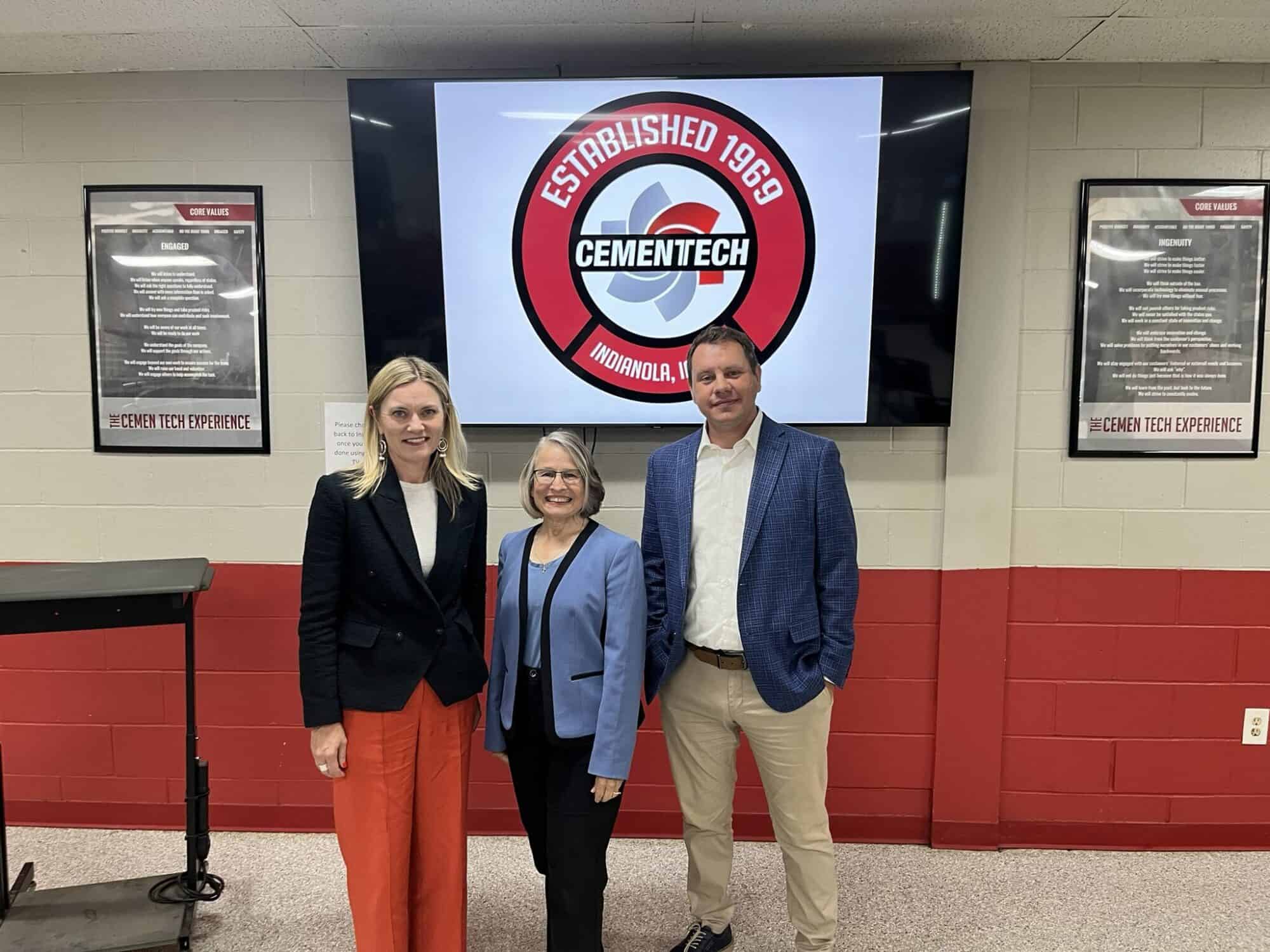
Rep. Mariannette Miller-Meeks (R-IA) visited Cemen Tech in Indianola, Iowa, for an employee town hall about how pharmacy benefit managers increase prices for manufacturing workers.
The event, hosted by Cemen Tech Chief Financial Officer Josh Maurer, allowed workers to engage directly with Rep. Miller-Meeks on the affordability of their health care, including prescription medicines.
The issue: The town hall focused on the need to reform PBMs, underregulated middlemen that drive up the costs of prescription medicines for manufacturers like Cemen Tech, the world’s largest manufacturer of on-demand concrete mixing equipment.
- Rep. Miller-Meeks discussed the DRUG Act, NAM-supported legislation that she introduced, which seeks to lower health care costs by delinking PBMs’ compensation from the list price of medicines—removing their incentive to push for higher prices.
- “PBMs distort the market, increasing the cost of prescription drugs for businesses and their workers,” Rep. Miller-Meeks explained. “That’s why I’m working in Congress to pass PBM reform that reins in these powerful actors.”
Manufacturers’ concerns: “We’ve seen health care expenses skyrocket, and a big part of that is due to the lack of transparency surrounding PBMs,” Maurer said during the town hall.
- “Cemen Tech and other small manufacturers like us are committed to providing affordable health care to employees, but it’s becoming increasingly difficult. PBM reform that addresses these rising costs is absolutely necessary.”
Addressing employee concerns: Cemen Tech employees also spoke about their struggles with the growing burden of health care costs across the board. Rep. Miller-Meeks explained that her proposed reform would have far-reaching effects: “It’s not only about reducing drug prices—it’s about ensuring that businesses can afford to continue providing health care benefits to their workers,” she said.
NAM in action: In addition to supporting the “delinking” provisions in the DRUG Act, the NAM is working with Congress on legislation to make PBMs’ opaque business practices more transparent and to ensure that savings from rebates are passed directly to manufacturers and their workers rather than being pocketed by PBMs.
The bottom line: “Manufacturers like Cemen Tech are essential to our economy, and ensuring they can thrive means addressing the rising costs of health care,” said Rep. Miller-Meeks. “PBM reform will free up manufacturers to do what they do best—build facilities, develop new product lines, increase wages and benefits and help the American economy grow.”
AO Smith’s Water Heaters Drive Building Efficiency
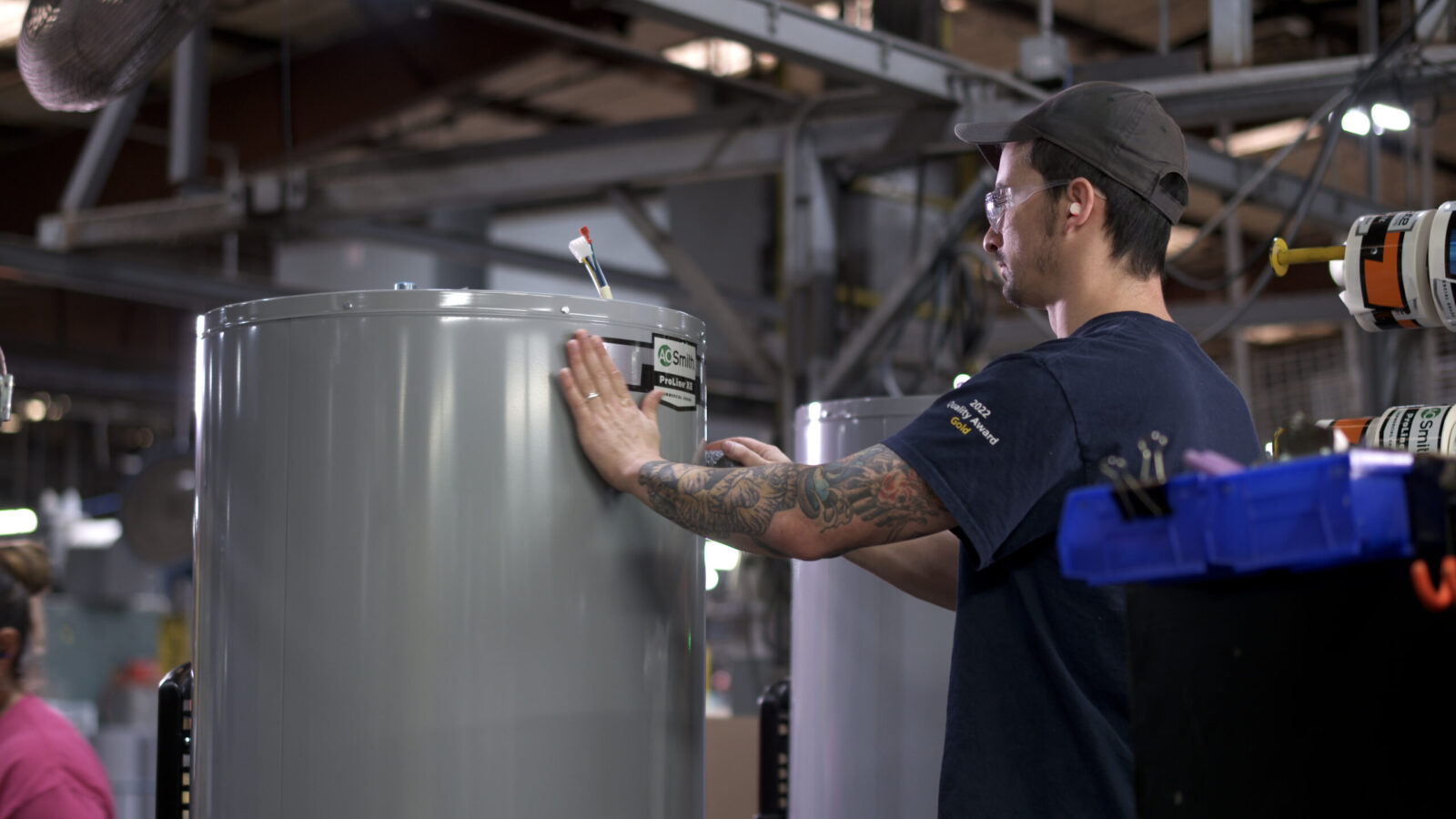
At AO Smith, the name of the game is efficiency. Though the company produces an array of water heaters, boilers, storage tanks and water treatment and filtration equipment, one goal is the same for every product: It should do more with less. This is especially true for hydronic and water heating appliances as these are energy intensive.
“On average, water heating loads are 25–30% of a home or building’s carbon profile,” said AO Smith Corporate Vice President of Government, Regulatory and Industry Affairs Joshua Greene.
- “After space heating and cooling, water heating is the next largest energy load in a home or commercial building. If you’re concerned about your energy spend, using heat pump technology is the most efficient way in which to reduce the overall spend on those heating loads.”
Efficiency in action: Recently, one of the Milwaukee, Wisconsin–based company’s water heating products—the CHP-120 fully integrated heat pump water heater—was installed in a Hilton property in New Haven, Connecticut, the all-electric Hotel Marcel, which opened in 2022 in the former headquarters of the Armstrong Rubber Company. Unlike conventional water heaters, which generate heat directly, heat pumps use electricity to move heat around.
- Hotel Marcel is the sole U.S. hotel to earn the U.S. Green Building Council’s Leadership in Energy and Environmental Design Platinum status in a decade.
The differentiator: The CHP-120 is the only unitary (one-piece) commercial heat pump water heater on the market. Comparable items use a split system in which one part, the compressor, sits outside of the building.
- The design enables Hotel Marcel and other customers to put the entire unit inside in a single room and “get the benefit of taking moisture out of the air in that room, then get to use the hot water that’s in the tank afterward, for laundry and other uses,” Greene told us.
- “So, it’s essentially free hot water—and you’re bringing down the ambient air temperature and humidity, which helps offset energy that would have been needed to cool that area.”
Gaining popularity: Current heat pump water heater customers are mostly residential homeowners, but in the commercial market, the technology has been growing at a rapid pace, Greene continued, because the energy savings “go straight to companies’ bottom line.”
- “Many states now offer rebates to help offset the higher upfront costs of the technology. As a result, we’re starting to install commercial heat pump water heaters in restaurants, schools, [more] hotels, multifamily housing” and more.
- A single CHP-120 installed in an apartment building, for example, can support several apartments depending upon on-site conditions, Greene said.
Overcoming barriers: Of the millions of water heaters (gas and electric) sold each year by manufacturers in the U.S., fewer than 3% are heat pump water heaters, Greene said. The main reason: price.
- “The average all-in project cost of a heat pump water heater is from $3,000 to $6,000” in the residential market, he went on. From a residential standpoint, “the average all-in cost of a 45-gallon gas or electric unit is about $800. It’s that cost delta that’s been the main impediment—but they’re 300 to 400 times more efficient, so one will save you 70% on your bill every month.”
- In the commercial market, heat pump water heating project costs are much higher due to size and other variables, but the energy savings can be exponentially larger, Greene added.
Regulation changes: With state and federal regulations and rebates, incentivizing high-efficiency technologies, heat pump water heater adoption—which is already on the uptick—will likely rise in many states in the coming years, according to Greene.
- “Now with robust federal tax credits and home energy rebates, coupled with utility rebates, they’re slicing that $3,000 to $6,000 [price tag] in half, and in places like California, you can get 80% or more of the cost covered.”
- AO Smith expects to stay busy, Greene said with a laugh.
Coming up: What’s next for a company that, in its 150-year history, has been at least three different businesses—having gone from automotive-frame maker to energy sector steel product manufacturer to leading global water technology company?
- “You can certainly expect to see continued innovation,” said Greene. “Our company has transformed a few times over the past century, and we will continue to evolve, with a focus on water technology, while adhering to the guiding principles and values that the Smith family established 150 years ago.”
NAM: Biden’s LNG Ban Threatens 900,000 Jobs
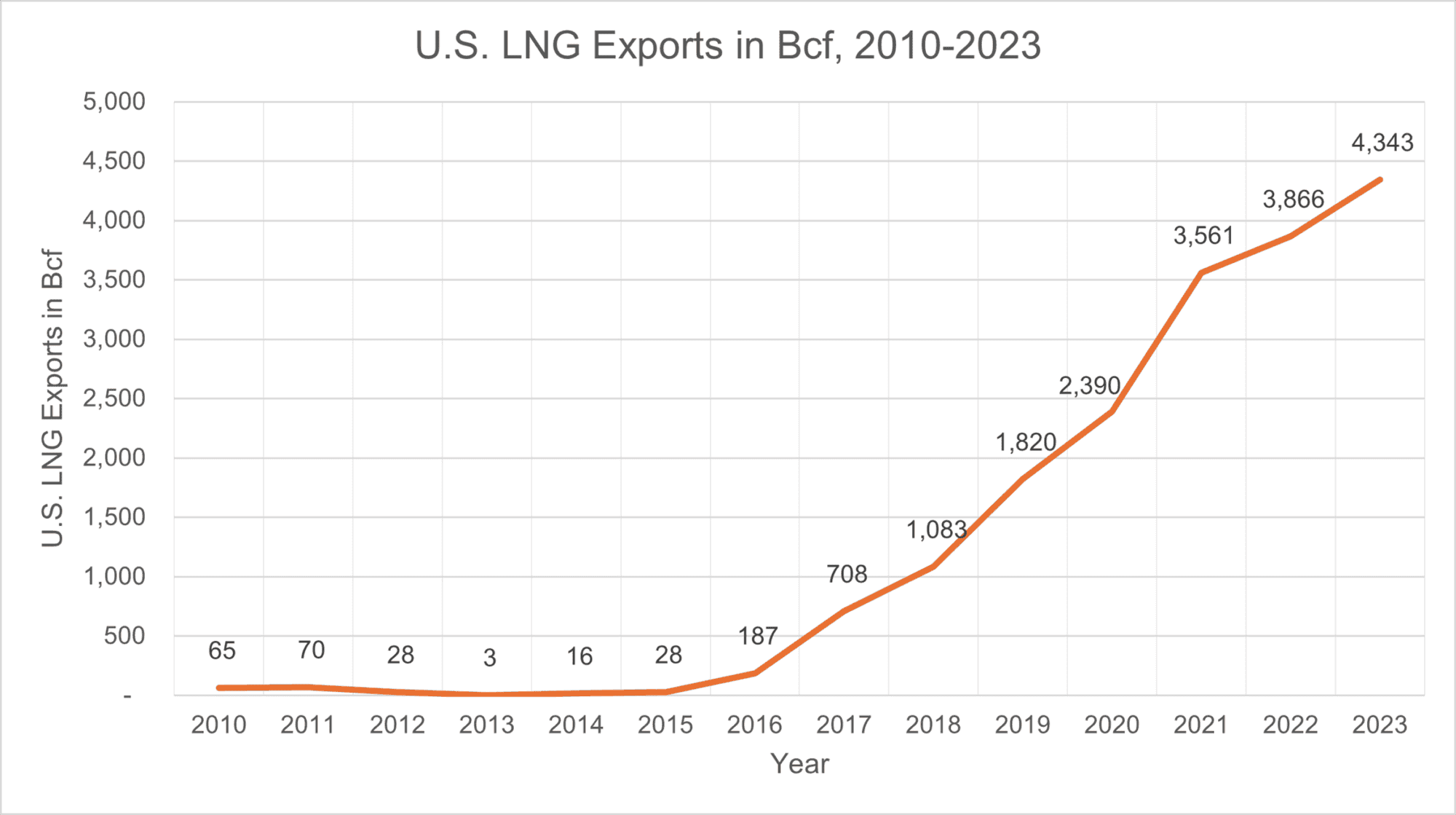
The liquefied natural gas export industry has turned the U.S. into a powerhouse of cleaner energy, benefiting its trading partners around the world. The Biden administration’s ongoing ban on new LNG export licenses, however, is throttling an industry that could produce many more billions in revenue and a startling 900,000 jobs by 2044.
The data: A new study from the NAM and PwC shows that the U.S. LNG revolution could extend its upward climb, as shown on the graph above. Today, the industry is a huge source of jobs and profit:
- U.S. LNG exports support 222,450 jobs, resulting in $23.2 billion in labor income.
- The LNG industry contributes $43.8 billion to U.S. GDP.
- And lastly, federal, state and local governments receive $11.0 billion in tax and royalty revenues, thanks to U.S. LNG exports.
But that pales in comparison to the industry’s potential over the next two decades. The study projects the likely growth of the industry through 2044, showing all that is at stake if the ban remains in place until then:
- Between 515,960 and 901,250 jobs, resulting in $59.0 billion to $103.9 billion in labor income, would be at risk.
- The ban would also stifle between $122.5 billion and $215.7 billion in contributions to U.S. GDP during the same period.
- Between $26.9 billion and $47.7 billion in tax and royalty revenues meant to benefit communities across the United States would also be at risk in 2044.
Public opinion: The American public is squarely behind the LNG export industry, showing overwhelming approval in an NAM poll taken in March.
- Eighty-seven percent of respondents agreed the U.S. should continue to export natural gas.
- Seventy-six percent of respondents agreed with building more energy infrastructure, such as port terminals.
The last word: “With LNG exports, we do not have to choose between what’s good for the economy and good for the planet. Today’s research shows the massive opportunity America has when we unleash our economic and energy potential,” said NAM President and CEO Jay Timmons.
- “Building LNG export facilities and expanding natural gas production are not just good for our industry—they also cut emissions and help power manufacturing around the world.”
Producer Prices Hold Steady as Energy Costs Drop
The Producer Price Index for final demand (also known as wholesale prices) was unchanged in September, after rising 0.2% in August. Over the past year, the final demand index rose 1.8% on an unadjusted basis, a slight decline from the 1.9% over-the-year increase in August. Prices for final demand excluding foods, energy and trade services inched up 0.1%, after rising 0.2% in August.
In September, prices for final demand services increased 0.2%, offsetting a 0.2% decline in prices for final demand goods. While both food (1.0%) and other goods (0.2%) prices saw an uptick, a 2.7% drop in energy prices more than balanced out those increases. The largest underlying increase was a 0.3% rise in transportation and warehousing services prices, although prices for both trade services and other services also increased slightly. The rise in transportation and warehousing services prices in September follows a significant price decline of 0.9% in August.
Prices within intermediate demand fell in September, continuing the declines from August. Processed goods for intermediate demand dropped 0.8%, with prices for processed energy goods leading the decrease. On the other hand, prices for processed foods and feeds rose 0.9%. Over the 12 months ending in September, prices for processed goods for intermediate demand fell 2.7%.
Meanwhile, prices for unprocessed goods for intermediate demand moved down 3.2% in September, after declining 3.1% in August. The decrease was driven by a 12.6% drop in unprocessed energy materials. In contrast, unprocessed foodstuffs and feedstuffs and nonfood materials less energy prices increased 2.7% and 1.9%, respectively. Over the 12 months ending in September, prices for unprocessed goods for intermediate demand fell a dramatic 9.5%.
